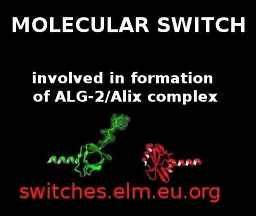The switches.ELM resource
Short linear motifs (SLiMs) are compact, degenerate protein interaction interfaces that predominantly occur in intrinsically disordered protein regions
(IDRs). Their intrinsic properties enable them to function as regulatory modules that can mediate switching between distinct functional states of a protein,
which allows for context-dependent, integrative regulatory decision-making (Davey et al., 2012)
(Van Roey et al., 2012).
The switches.ELM database curates experimentally validated motif-based molecular switches, thereby providing a valuable collection of regulatory data that were
dispersed in literature. In addition, based on these validated instances, the switches.ELM prediction tool was developed to identify possible switching mechanisms that might
regulate a motif-containing protein of interest. Based on the underlying mechanisms, different types and subtypes of motif-based molecular switches were defined,
an overview of which can be found on the 'Switch types' page.
The switches.ELM resource was curated and developed by the ELM consortium at the Gibson Team, EMBL Heidelberg.
Download a movie about a molecular switch involved in the formation of the ALG2/Alix complex:
References
switches.ELM
The switches.ELM Resource: A Compendium of Conditional Regulatory Interaction Interfaces. Van Roey et al., 2013
Further reading
- Motif switches: decision-making in cell regulation. Van Roey et al., 2012
- ELM--the database of eukaryotic linear motifs. Dinkel et al., 2012
- Attributes of short linear motifs. Davey et al., 2012
- A dynamic view of domain-motif interactions. Akiva et al., 2012
- How viruses hijack cell regulation. Davey et al., 2011
- Intrinsically disordered proteins: regulation and disease. Babu et al., 2011
- Protein binding specificity versus promiscuity. Schreiber et al., 2011
- Transient protein-protein interactions: structural, functional, and network properties. Perkins et al., 2010
- Protein dynamics and conformational disorder in molecular recognition. Mittag et al., 2010
- Post-translational modifications in signal integration. Deribe et al., 2010
- Cell regulation: determined to signal discrete cooperation. Gibson, 2009
- Understanding eukaryotic linear motifs and their role in cell signaling and regulation. Diella et al., 2008
- Linear motifs: evolutionary interaction switches. Neduva et al., 2005
External data resources / tools
Acknowledgements
The switches.ELM resource is supported by: